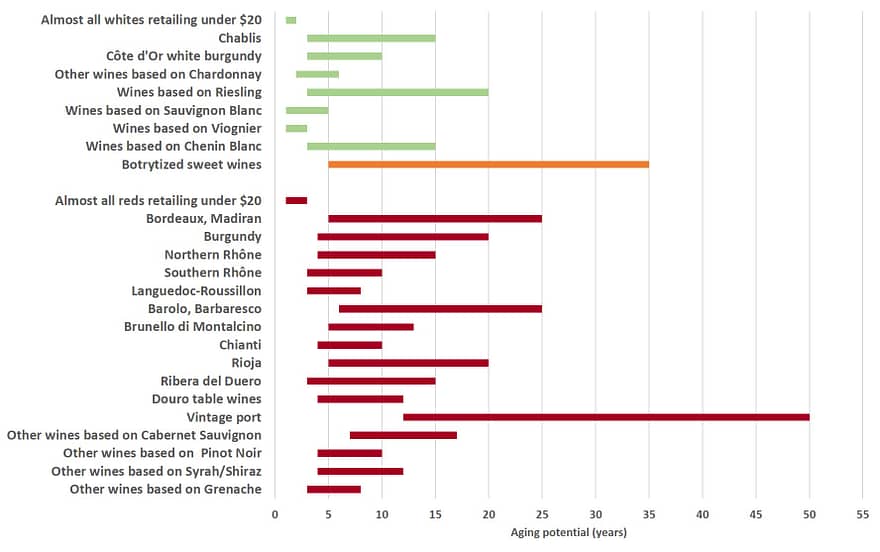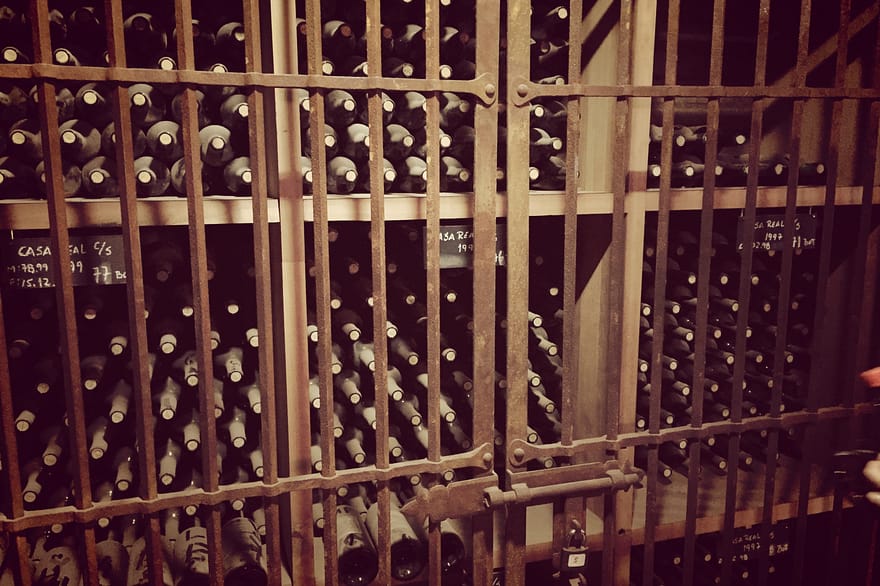How long should I wait to open my bottle of wine?
Why should I let the wine age? If at all.
Wine is a living thing and is trying hard to become vinegar, as discussed in a previous post.
A bit of art and technique come into play to slowdown the time for wines said to have aging or development potential. Magic happens if we open the wine at the right point of its lifetime curve.
When it comes to the line “the older the wine the better”, it is not always true. Especially if there are taste preferences involved. Not all wines are worth aging. In reality, most of the wines produced today reach the shelves ready to be drank.
Besides the production costs and retail margins, there are subjective elements that might contribute to the price you see in a wine bottle. One of these overheads is attributed to the aging potential. What does that mean?
Aging is described by a slow and sustained oxidation of the wine. During this process, the wine goes through some changes that impact its flavors, texture and color.
If a wine is designed to age or has aging potential, opening that wine ahead of time might not be “too bad”. However, you might be throwing away the share of the price you paid for its aging potential, and you might not benefit from some features of the wine you actually paid for.
How does aging impacts the wine?
Wines with good structure are prone to have good aging potential. In other words, the elements that form the wine structure evolve in harmony overtime, improving the overall balance of the wine.
Two elements change the most with aging: tannins and acidity. Acidity tends to decrease over time, bringing down also the descriptors that correlate with the freshness of the wine. Tannins tend to combine into larger chains (polymerization), resulting in a rounder and softer presence of the wine on the palate.
Red wines tend to become lighter in color. White wines tend to become darker, instead.
As consequence to the changes in the wine structure, the taste and aromas also change their profile.
Flavors (the joint perception of taste + aroma) are classified in three layers. Those are based on the origin of the aromatic compounds produced along the grape-to-wine journey:
PRIMARY (OR VARIETAL) FLAVORS, derive directly from the grape variety. The anthocyanin from the grape skins are transferred to the juice during maceration. Primary aromas as strongly influenced by climate, soil and degree of ripeness of the grapes. Example: asparagus, cherry, herbal aspects, green pepper, violets, lime, orange blossom.
SECONDARY FLAVORS develop during various stages of the alcoholic fermentation process. Those are influenced by the winemaking process and temperatures sustained during each stage. Example: pineapple, banana, butter, honeycomb, almonds, mango, brioche, freshly baked bread, black pepper.
TERTIARY FLAVORS develop during the slow and steady oxidation of the wine along the aging process. Example: cocoa powder, cigar box, leather, tobacco, vanilla, caramel, truffle, musk, coffee.
As a result of aging, the bright, fresh, crisp and vegetal aromas give way to ripe, dried or stewed fruit. Spices also become more evident and include descriptors such as leather, cigar, musk, truffles and chocolate.
So, technically, if you’d like to savor tertiary flavors in your wine (assuming it has the ability to develop them) you will need to wait for time to work its magic.
When to open that bottle?
We say that a wine is at its peak when it reaches the point of its best expression, during its life cycle.
It doesn’t mean that a wine is not ready to drink before its peak. Great wines are already great before reaching the best version of themselves.
As a reference on how each wine has its own developing period, I am sharing below an oversimplified view on aging potential. The reference was taken over better quality wines from the indicated regions or made from the indicated grape varieties. It is important to remember that this depends a lot on the vintage, winemaker, storage conditions, and many other factors. Those were taken from Jancis Robinson “The Oxford Companion to Wine”.

Current Trends
With the improvement of production methods and ever-changing consumer preferences, producers are shifting the profile of their wines to adapt to those swings. More traditional producing regions such as France and Italy have been tweaking their production, creating wines that don’t require too much cellar time before they are drinkable.
In Bordeaux, as an example, Saint Estèphe has been incorporating more Merlot into its grand vins to make them more approachable. This is a change in their style as Saint Estèphe wines are known to be quite austere in their youth.
In Italy, Barolo is one of the most classic examples of a wine built to age. It requires at least 3 years of aging process (or 5 if reserve) before it reaches the market. Meaning that if you look at your preferred wine store now, the youngest vintage of Barolo you will find is from the vintage of 4 years ago. Besides, it has a developing potential of a couple of decades.
The “Barolo Boys”
There is the famous story about the “Barolo boys”, who created a revolution in the 80’s in Piemonte. Elio Altare and a few of his friends stepped a bit over the feet of tradition when chasing their dreams. Their goal was to improve the quality of Barolo wines while reducing the aging needed to have it drinkable. Spoiler: they introduced the concept of production for quality over quantity, by reducing the yield. But the big step came with them introducing the use of barrique (225 liters) in the process of making Barolo. Not only improving its complexity but also speeding up aging, by increasing the contact surface of the wine with the wood for aeration. Until then it has been used “botti” (400 liters and above).
The innovation movement sparked a revolution putting on debate how much culture and tradition should give space to innovation (at least when it comes to wine).
Aging as part of the experience
There is still a lot of marketing and speculation when it comes to aging potential of wines. The point on the higher price sometimes is, are you ok on paying more for an old wine or you’d rather pay less for a younger version and keep it in the cellar until the right time comes? If it’s all about the flavors and curiosity, investing in an old bottle and drinking it now could be an interesting option (especially if building a wine collection in the cellar is not your goal).
Having said that, it’s not always true that old wine taste better than young ones. They sometimes are just different. Age contributes to changes in the wine that you need to wait and see the results.
Wine appreciation is also about context and environment. The waiting and expectations raised on the process add story and romance to the bottle, besides the tertiary flavors.
Sometimes, the older the vintage the heavier the weight of memories attached to it. And that’s when aging finds a way to add a perception of value that is personal to each one.
Aging becomes part of the value when you bring home a crate of Riesling from your memorable trip to Alsace. You will be reviving the trip every time you open one of those bottles, through the years. Or the crates you bought on your wedding and that you keep on opening at each anniversary. Celebrating, remembering and enjoying how that vintage is evolving over time… together with your relationship.
The evolution inside the bottle and the savoring of the memories attached to it will have a taste that only the patient touch of time can build.

